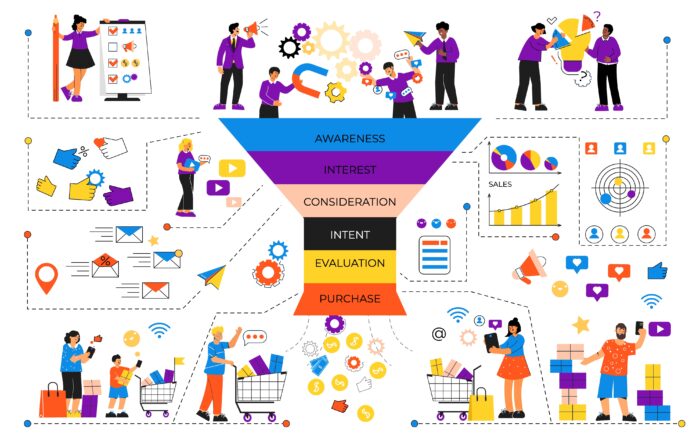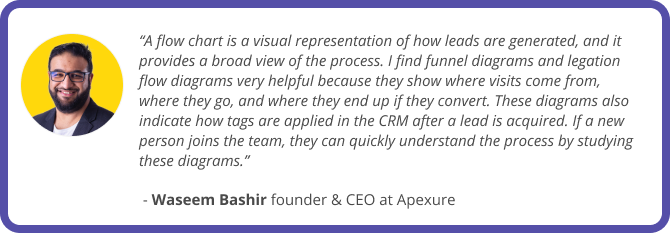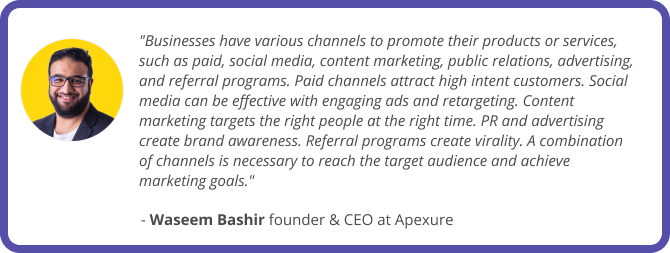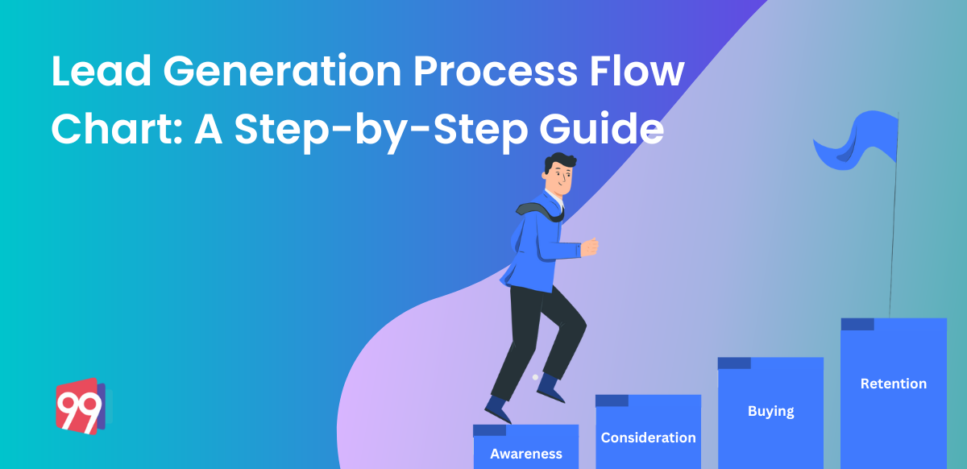A lead generation process flow chart makes it easier to scale marketing efforts through efficient planning.
Lead generation is a crucial process for attracting quality leads and converting them into long-term customers. However, marketers approach this process differently, leading to inconsistency and low conversion rates.
To ensure successful lead-generation efforts, brands should understand the framework of every marketing campaign. Although lead generation marketing strategies may differ, they all fit in some way or another at various stages of a lead generation process flow chart.
In this blog, we will discuss the lead generation flow chart in detail. It will help you better understand how to create targeted marketing efforts for higher conversions.

Table of Contents:
- Overview of Lead Generation Process Flow Chart
- Target Audience Alignment in the Lead Generation Process Flow Chart
- How To Create Buyer Personas For Lead Generation Process
- Lead Generation Process Flow Chart Explained
- Conclusion
What is a Lead Generation Process Flow Chart?
Lead generation is a process that starts by identifying target prospects and then building relationships with them. But having paid ads and a good website is not enough to generate leads. According to research, consumers want more personalised content. And they want it delivered to them in a way that’s interesting and relevant.
That’s why lead generation processes involve several different channels:
– Paid ads
– Social media
– Content marketing
– PR and advertising
– Referral programs
..and more!
All of these marketing channels collaborate to build a customer base. And once you have a customer base, you can begin to promote your products or services. The main objective of lead generation process is to convert those leads into paying customers as quickly and efficiently as possible.
A lead generation process flow chart aims to align all such marketing campaigns into a user experience that encourages them to convert from visitor to lead and eventually a paying customer.
It is a simple way of organising brand marketing in a way that is interactive and interesting for visitors to convert.
A lead generation flow chart helps markets create more focused campaigns and stay informed about the buyers’ journey.
Let’s understand how it works.

Target Audience Alignment in the Lead Generation Process Flow Chart
The lead generation process flow chart requires precise alignment with your target audience. It’s about reaching potential customers and resonating deeply with them at every touchpoint.
To begin your journey, it is essential to conduct thorough market research to gain a deep understanding of your audience’s demographics, behaviors, and pain points.
This step of the lead generation process flow chart lays the groundwork for creating detailed buyer personas that represent different segments of your target audience. These personas enable you to customize your messaging and approach to address each group’s specific needs effectively.
Once you have this foundation, you can develop a multifaceted content strategy that leverages different formats and channels to engage your audience across various stages of their buyer’s journey.
This strategy allows you to create various types of content, such as blog posts, videos, webinars, and social media content, tailored to tackle the problems faced by your audience and offer them valuable solutions.
Moreover, utilize advanced targeting and personalization techniques in your advertising campaigns to guarantee that your message reaches the appropriate individuals at the correct time.
By aligning every aspect of your lead generation process with your audience’s preferences and behaviors, you can attract high-quality leads, foster deeper connections, and drive long-term engagement and loyalty.
Understanding the importance of the target audience and how to build personas is crucial in this process. Buyer personas help you humanize your audience, providing insight into their motivations, pain points, and decision-making processes.
Utilize these personas to inform your content creation, messaging, and targeting efforts. This will ensure that your lead generation initiatives resonate with your audience on a personal level and drive meaningful engagement.
By honing in on your audience’s needs and preferences, you can revolutionize your lead generation efforts and propel your business toward sustainable growth.

How To Create Buyer Personas For Lead Generation Process
For a lead generation process flow chart and to effectively target your audience, it’s important to conduct thorough research. You can use surveys, interviews, and social media insights to gather data on your target audience. After gathering data, identify the characteristics of your audience such as demographics (age, gender, location) and psychographics (interests, challenges, goals).
Based on your research, create detailed profiles for different sehttps://99landingpages.com/ways-to-improve-customer-retention/https://99landingpages.com/ways-to-improve-customer-retention/gments of your audience. These profiles should include important details such as demographics, interests, and pain points.
To ensure that your personas are accurate, use real data from your customer database to validate them. Once validated, create visual aids such as infographics or persona cards to make your personas easy to understand and remember.
Share your personas with relevant teams and gather feedback to ensure alignment across your organization. It’s important to keep your personas up to date by regularly reviewing and updating them based on new data and insights.
Lead Generation Process Flow Chart Explained
Marketers divide the lead generation flow chart into four stages:
#Stage 1: Awareness
In the lead generation process flow chart, awareness is at the top. It deals with making your target audience aware of your brand. The main aim of the awareness stage is to convert visitors into leads by sharing content they will find helpful.
It focuses on establishing your brand as a market leader by answering common consumer queries and collecting potential prospects’ information.
Therefore, businesses execute marketing campaigns under Stage 1 through various means, including web forms, landing pages, paid ads, informational blogs, etc.
Data collected from this stage varies based on what type of lead generation strategy you are using.
For example, if you are collecting leads through a web form, your data will include names, email addresses, company names, phone numbers and other contact information. Your data will be more qualitative if you collect leads through social media ads (like Facebook).
They might include questions about the respondent’s interests and how they want to be contacted.
At this stage of the process flowchart, it’s important to note that not all types of data need to be collected. Your lead generation process strategy will determine which data needs to be collected in the process flowchart based on your business goals.
Optimizing The Awareness Stage of the Lead Generation Process
To improve the lead generation process flow chart’s awareness stage, develop a targeted content strategy that addresses audience needs and preferences through various formats, such as videos, infographics, and interactive tools.
Tailor your message to resonate with different audience segments. Use personalization techniques and dynamic content for a customized experience.
Implement an integrated omnichannel approach to reach your audience across multiple touchpoints, ensuring consistency in branding and messaging.
Optimize lead capture forms and landing pages to maximize conversion rates, keeping forms simple and concise while utilizing progressive profiling to gather additional data over time.
Continuously measure and analyze campaign performance, adapting strategies based on insights gleaned from industry trends, competitor activities, and consumer behaviors.
#Stage 2: Consideration
After capturing the prospects’ attention, you need to nurture those leads so they don’t get lost!
That’s where email marketing comes in. If a lead fills out your contact form, businesses can start by emailing them to thank them for their interest and give them more information about the specific products and services that cater to the lead’s needs.
If consumers fill out your lead generation form, you’ll want to follow up with them and ensure they have all the information they need before reaching out to your sales team or making that purchase decision.
Finally, if the lead decides not to buy anything from you, it’s important not to lose touch! You can keep sending emails or posting on social media about new products or deals- anything to keep them engaged with your business.
Optimizing The Consideration Stage of the Lead Generation Process
Personalizing communication and providing valuable content to optimize the lead generation process is crucial. Use dynamic content and segmentation techniques to tailor email outreach according to each lead’s specific interests and needs for targeted messaging.
Provide valuable resources such as ebooks or webinars that address potential challenges, positioning your products or services as practical solutions. Implement automated nurture sequences that guide leads through their buyer’s journey, providing relevant information and building trust.
Reinforce your message by extending nurturing efforts across multiple channels, such as social media and retargeting ads. Prioritize and personalize communications by utilizing lead scoring and segmentation, adjusting follow-up cadence based on engagement metrics.
Through these strategies, you can effectively nurture leads, keeping them engaged and guiding them toward informed purchase decisions.

#Stage 3: Buying
The next step is converting the visitor’s interest into a lead by getting their contact information.
For example, if someone wants more information about your product after seeing your PPC ad or reading your blog post, you’ll ask for their name and email address to provide more details. You won’t actually follow up with sales until they’ve agreed to be contacted by salespeople via email or other means of communication.
That way, you’ll have a contact list of leads instead of prospects who have no intention of buying from you.
Nurturing your leads to customers involves following up with them regularly with relevant offers and reminding them why they should buy from you instead of competitors.
If a customer agrees to buy from you after being nurtured, salespeople must contact them (via phone or email), and they will officially become customers.
Optimizing The Buying Stage of the Lead Generation Process
To optimize the buying stage of your lead generation process, it’s crucial to streamline the lead capture process and reinforce your value proposition effectively. Simplify the process for visitors to provide their contact information, utilizing user-friendly forms and interactive tools.
Throughout this stage of the lead generation process, continue to emphasize the unique benefits and advantages of choosing your offerings over competitors, addressing any lingering doubts or objections.
Personalize follow-up communications with leads, tailoring offers and incentives based on their specific needs and stage in the buying process.
Implement strategic lead nurturing strategies, including automated workflows and targeted content, to keep leads engaged and guide them towards making a purchase decision. Provide sales teams with the necessary support and resources to effectively engage with leads and close deals successfully.
By continuously monitoring performance metrics and gathering feedback, you can identify areas for improvement and refine your approach to maximize conversion rates and drive business growth.
#Stage 4: Retention Change
The retention stage is a continuous process in the lead generation process flowchart. It involves maintaining the interest of existing customers and encouraging them to make repeat purchases.
To achieve this, marketers need to offer exceptional services, provide efficient customer support, and utilize cross-selling and upselling strategies. It’s important to ensure that every customer feels comfortable sharing their feedback, complaints, or inquiries via phone, email, or chat.
By offering discounts and other membership options, you can help the customers in staying connected with you.
Optimizing The Retention Stage of the Lead Generation Process
To bolster the retention stage of your lead generation process, it’s essential to prioritize proactive customer engagement and exceptional support services.
Encourage open communication channels, allowing customers to freely express their thoughts and concerns via various mediums like phone, email, or chat.
Provide prompt assistance and utilize technology-driven solutions to streamline support processes, ensuring swift resolution of issues.
Additionally, personalize upselling and cross-selling efforts based on customer preferences and purchase history, offering relevant products or services to enhance their overall experience.
Offer membership programs and rewards to incentivize engagement, gather feedback to improve and refine your offerings, and cultivate a sense of community among customers to strengthen relationships and promote advocacy.
Through these strategies, you can effectively cultivate lasting relationships and drive customer retention.
Conclusion
Lead generation is a crucial process for businesses that want to attract high-quality leads and turn them into loyal customers.
To achieve this, it is essential to understand the importance of aligning with the right audience and creating detailed buyer personas. This allows businesses to tailor their marketing efforts to resonate effectively with their intended audience.
A well-structured lead generation process flow chart ensures that marketing campaigns are strategically aligned with the buyer’s journey, from awareness to retention. Each stage of the process presents unique opportunities for optimizing strategies and maximizing conversions.
By implementing targeted tactics and leveraging various marketing channels, businesses can nurture leads, guide them through the buying process, and foster long-term customer relationships.
Check Out Our Featured Templates:





